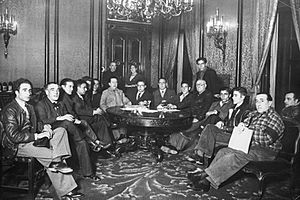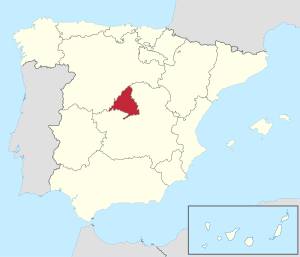Madrid Defense Council facts for kids
Quick facts for kids Madrid Defense Council
Spanish: Junta de Defensa de Madrid
|
|||||||||
|---|---|---|---|---|---|---|---|---|---|
| of |
|||||||||
| 1936–1937 | |||||||||
 |
|||||||||
 Location of the Province of Madrid within Spain |
|||||||||
| Capital | Madrid | ||||||||
| Demonym | madrileño, -ña | ||||||||
| Area | |||||||||
| • Coordinates | 40°25′08″N 3°41′31″W / 40.4189°N 3.6919°W | ||||||||
| Government | Defense Council | ||||||||
| • Type | Council Republic | ||||||||
| • Motto | "Long live Madrid without government!" Spanish: Viva Madrid sin gobierno! |
||||||||
| President | |||||||||
|
• 1936–1937
|
José Miaja | ||||||||
 Coat of arms |
|||||||||
| Historical era | Spanish Civil War | ||||||||
|
• Government flees to Valencia
|
November 6, 1936 | ||||||||
|
• Established
|
7 November 1936 | ||||||||
|
• Siege of Madrid begins
|
November 8, 1936 | ||||||||
| February 6 – 27, 1937 | |||||||||
| March 8 – 23, 1937 | |||||||||
|
• Disestablished
|
23 April 1937 | ||||||||
| March 28, 1939 | |||||||||
|
|||||||||
The Madrid Defense Council (known in Spanish as Junta de Defensa de Madrid) was a special group that governed the city of Madrid, Spain. It was formed in November 1936 during the Spanish Civil War (1936–1939).
This council took charge after the main Spanish government moved from Madrid to Valencia. This happened because General Francisco Franco's forces were getting very close to Madrid. People thought the city would fall quickly. However, the arrival of the International Brigades helped stop the attack. This led to a long standoff.
The council was mostly led by communists. They were very good at organizing and spreading their message. Their main goal was to turn local fighters into a regular army. They wanted to focus on winning the war. Over time, there were disagreements between the communists and other groups. The council was eventually replaced by a new city council in April 1937.
Contents
How the Council Started
At the beginning of November 1936, rebel armies led by General Francisco Franco were nearing Madrid. They easily pushed past the local fighters, who were not well-trained or equipped. The government of the Second Spanish Republic had not prepared Madrid's defenses. They did not want to worry the people.
On November 6, 1936, the government left Madrid for Valencia. They left General José Miaja in charge of defending the city. Miaja was told to protect Madrid "at all costs." This seemed like an impossible task. He had secret orders to create a Defense Council.
News reports around the world said Madrid would not be defended. General Franco even announced that the city had been "liberated" too soon. On November 7, Franco's first troops reached the edge of Madrid. On that same day, the Madrid Defense Council was announced.
By order of the political and worker groups, and following the Republic's government, a Defense Council has been formed in Madrid. It includes all groups that are part of the government and are helping in the fight happening at Madrid's gates.
The Defense Council desperately needed more people and supplies. But Franco's forces were spread thin. They only had about 3,000 men ready to enter the city. Franco was also very careful. The first groups of the International Brigades arrived on November 8, 1936. They immediately joined the fight. As more fighters arrived, the rebel advance stopped. By November 23, both sides were tired, and the fighting became a stalemate.
Who Was in the Council?
General Miaja was a conservative but loyal to the Republic. He was very close to the Spanish Communist Party (PCE). The PCE used propaganda to make Miaja a hero for defending Madrid. Some people later thought Miaja was a PCE member himself.
Pedro Checa and Antonio Mije worked with Miaja to ensure many communists were on the council. Miaja was told that all parties should be included based on their size in the government. However, the communists ended up with more seats than they should have.
The PCE and the Unified Socialist Youth (JSU) were the most organized groups. They had the best ways to spread their message. Because of this, they had a lot of power in the council. The anarcho-syndicalist group CNT also joined the council. They famously declared, "Long live Madrid without government!"
The POUM (Workers' Party of Marxist Unification), which was against the main communist ideas, was not allowed to join. This was because the communists insisted on it. The POUM's newspaper, La Batalla, claimed that the Soviet ambassador had stopped them from joining.
Most of the main politicians had left Madrid. So, the council members were mostly "young men who chose to stay in the city," as Vicente Rojo Lluch wrote. A group of British politicians who visited Madrid said the government seemed to be run by "young men, sometimes barely of age." They were "enthusiastic working-class lads" trying their best.
The communists held most of the important jobs. They were very strong in the Propaganda and Press department. A German communist named Kurt Hager was in charge of the official Radio Madrid. The communists gained respect and power because the Soviet Union sent tanks, airplanes, and advisors.
What the Council Did
The council became the real government of Madrid. It was based in the War Ministry. Santiago Carrillo, who was in charge of Public Order (police), put five of his closest friends in key police jobs. All of them were communists or joined the party soon after. The communists quickly gained full control of the police.
Pablo Yagüe, in charge of Supplies, immediately set rules for buying food. Shoppers could only buy food at one store. If that store ran out, they could try others in the same area. As the city was under siege, Yagüe also had to deal with rising prices.
The Defense Council was reorganized and renamed the Junta Delegada de Defensa de Madrid. This happened on November 25, 1936, by order of Largo Caballero. This change was to show that the council was under the main government. After the name change, members were called Delegates instead of Councillors. On December 2, 1936, the Defense Council met again with Miaja as chairman. Some changes happened in the following weeks.
On December 12, 1936, newspapers reported that the council decided to turn local militia groups into regular army units. Only these new units would get paid and receive supplies. On December 23, 1936, Yagüe was shot at a roadblock. He was badly hurt and replaced by Luis Nieto de la Fuente. On December 24, General Miaja announced that militias should leave all checkpoints. Security and Assault Guards would replace them.
There were incidents where members of the CNT or PCE were found dead. A rule was made to disarm militiamen without a permit from the Public Order Delegate. However, the Council rejected this rule.
On January 16, 1937, the Council changed its propaganda department. This gave it more control over censorship, exhibitions, and posters. Most posters were made by the UGT's Union of Professional Draftsmen. The council's posters focused on defending the "democratic republic" and defeating the rebels. They criticized those who wanted big social changes. They wanted a strong, central military. They also expected women to work in farms and factories, not on the front lines. This was different from what some CNT members and the POUM believed.
On January 29, 1937, Isidoro Diéguez Dueñas suggested taking over the POUM radio station and newspaper. He claimed they were only "fighting the government and the Popular Front." This idea was approved by everyone. José Cazorla then said he would take over all POUM buildings and vehicles, calling the group "illegal." This was also approved without anyone disagreeing. The communist press said the council's decision proved the POUM was fascist. After the city of Málaga fell in February 1937, the council tried to remove army leaders who did not follow its authority.
By April 1937, there was growing tension between the CNT and the communists. It seemed that Socialists, Anarchists, and Republicans were starting to unite against the communists. Largo Caballero felt more and more alone. He did not like how much Miaja was praised. So, he dissolved the council on April 23, 1937.
The reason given was an article in the CNT newspaper Solidaridad Obera. This article said that the JSU, which was in charge of public order, had closed an anarchist paper. In that paper, Melchor Rodríguez García, who managed prisons in Madrid, had said that communists were running secret prisons. Rodríguez had shared details about how people were treated in these prisons. He blamed the communist Security Delegate, José Cazorla. The Defense Council was then replaced by a new city council.
Council Members
The people who were part of the council included:
| Position | Start Date | End Date | Officeholder | Organization | Political Group | |
|---|---|---|---|---|---|---|
| President | November 6, 1936 | April 23, 1937 | General José Miaja | EPR | Independent | |
| Secretary | November 6, 1936 | December 1, 1936 | Fernando Frade | PSOE | Socialist | |
| December 2, 1936 | April 23, 1937 | Máximo de Dios | PSOE | Socialist | ||
| Public Order (Police) | November 6, 1936 | December 27, 1936 | Santiago Carrillo | JSU | Communist | |
| December 27, 1936 | April 23, 1937 | José Cazorla Maure | JSU | Communist | ||
| War | November 6, 1936 | December 1, 1936 | Antonio Mije | PCE | Communist | |
| Militias | December 2, 1936 | April 23, 1937 | Isidoro Diéguez Dueñas | PCE | Communist | |
| War Industries | November 6, 1936 | December 1, 1936 | Amor Nuño | CNT | Anarcho-Syndicalist | |
| December 2, 1936 | January 15, 1937 | Mariano García Cascales | FIJL | Anarchist | ||
| January 15, 1937 | April 23, 1937 | Lorenzo Íñigo Granizo | FIJL | Anarchist | ||
| Supplies | November 6, 1936 | December 23, 1936 | Pablo Yagüe | UGT | Communist | |
| December 23, 1936 | April 23, 1937 | Luis Nieto de la Fuente | UGT | Communist | ||
| Communications and Transport | November 6, 1936 | December 1, 1936 | José Carreño España | IR | Left Republican | |
| Transport | December 2, 1936 | January 15, 1937 | Amor Nuño | CNT | Anarcho-Syndicalist | |
| January 15, 1937 | April 23, 1937 | Manuel González Marín | CNT | Anarcho-Syndicalist | ||
| Finance | November 6, 1936 | December 1, 1936 | Enrique Jiménez González | UR | Republican Union | |
| Information and Liaison | November 6, 1936 | December 1, 1936 | Mariano García Cascales | FIJL | Anarchist | |
| Propaganda and Press | December 2, 1936 | April 23, 1937 | José Carreño España | IR | Left Republican | |
| Evacuation | November 6, 1936 | December 1, 1936 | Francisco Caminero Rodríguez | PS | Syndicalist | |
| December 2, 1936 | April 23, 1937 | Enrique Jiménez González | UR | Republican Union | ||
| Services | December 2, 1936 | April 23, 1937 | Francisco Caminero Rodríguez | PS | Syndicalist |
See also
 In Spanish: Junta de Defensa de Madrid para niños
In Spanish: Junta de Defensa de Madrid para niños



